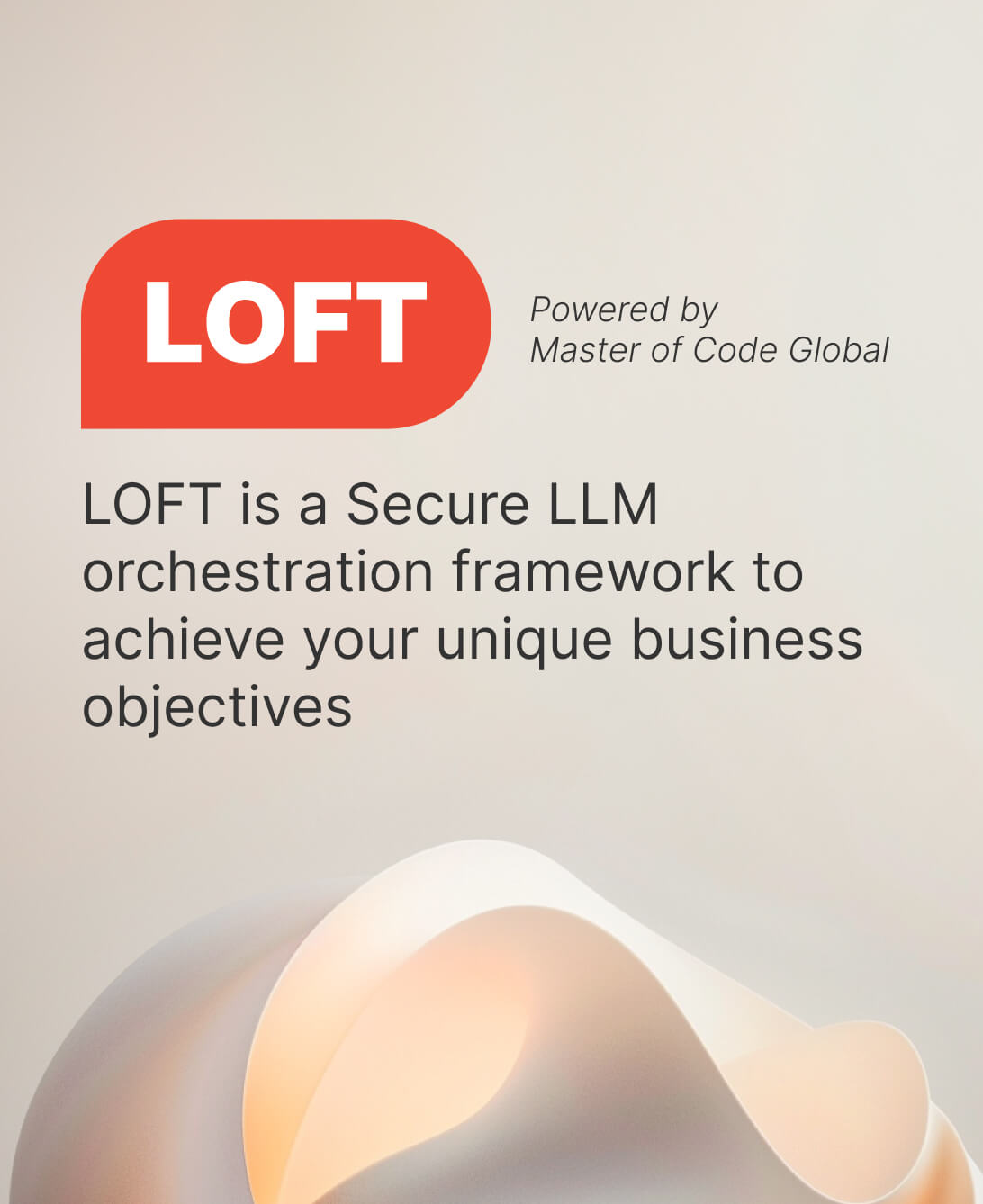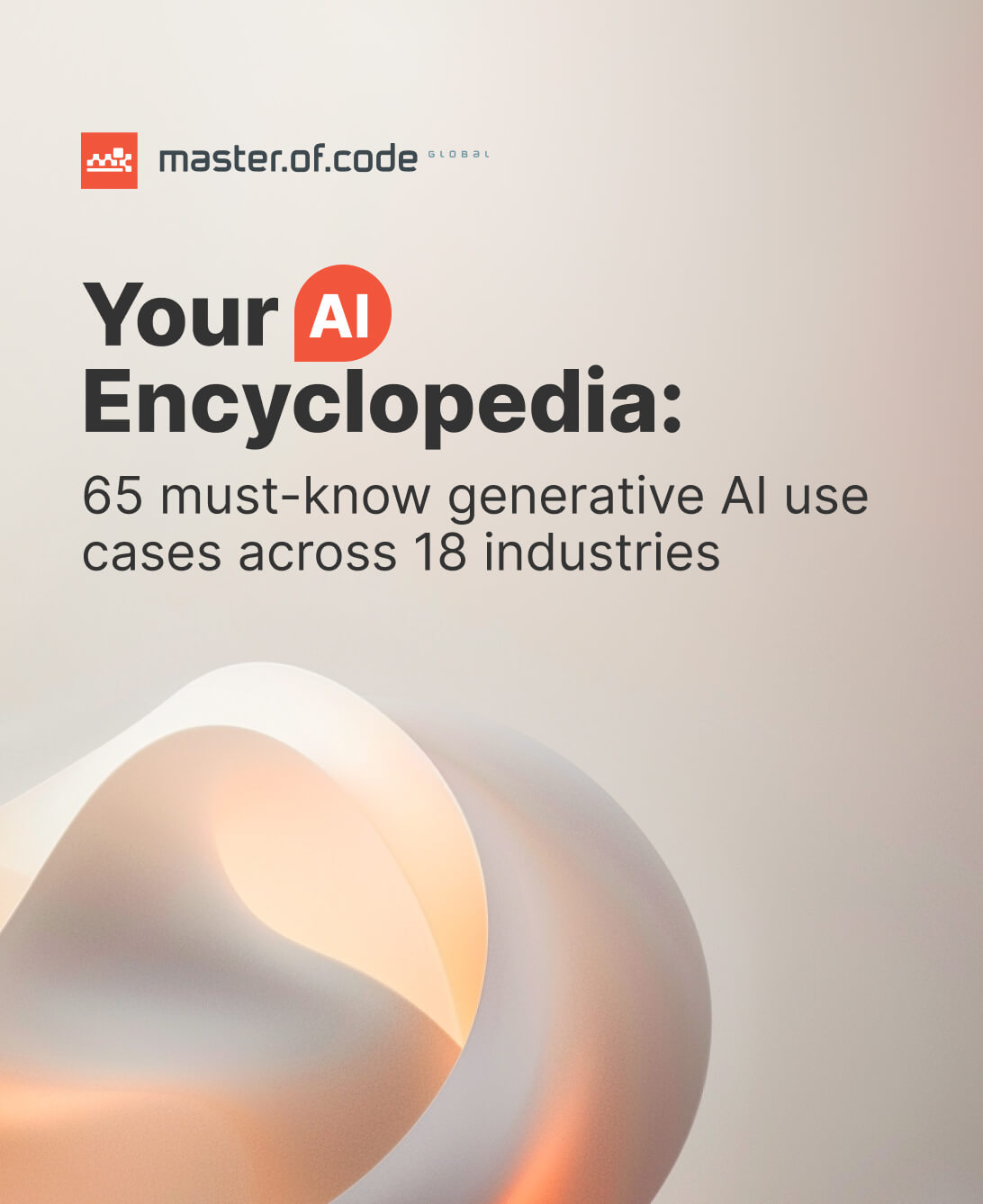In recent years, as per chatbot statistics the market has experienced remarkable growth. It is fueled by the increasing demand for 24×7 customer services and operational cost reduction. Moreover, there is a rising preference for self-service operations. Businesses are automating sales and support services, enabling timely services at reduced costs. This evolution is underscored by significant chatbot and AI statistics:
- The chatbot market is set to expand at a remarkable 23.3% annually, reaching $15.5 billion by 2028.
- 87.2% of consumers rate their interactions with bots as either neutral or positive. 62% of respondents prefer engaging with customer service digital assistants rather than waiting for human agents.
- Chatbots have the potential to automate 30% of tasks performed by today’s contact center staff. This can lead to potential savings of $23 billion in the U.S.
- Bots can manage 30% of live chat communications and 80% of routine tasks.
- Chatbots have remarkably accelerated response times, delivering answers three times faster on average.
- Digital assistants are most frequently employed in sales (41%) and client services (37%). Marketing (17%) is the third most common application.
Now, let’s explore the impact of bots across various industries and their benefits analyzing available chatbot statistics.
Table of Contents
Master of Code Global Picks: Top Chatbot Stats
Chatbots User Engagement and Expectations:
- 80% of users have had prior interactions with chatbots.
- Only 9% of consumers oppose companies using digital assistants.
- 73% of users expect websites to feature chatbots for convenient interactions.
- 35% of individuals turn to digital assistants to address complaints or obtain detailed information.
- 74% of internet users prefer using chatbots for simple questions.
Chatbots Business Integration and Benefits:
- 58% of B2B companies integrate chatbots into their websites, compared to 42% in B2C settings.
- Approximately 2/3 of companies express contentment with their bot implementations.
- Digital assistants resolve 58% of returns and cancellations.
- 90% of businesses witnessed faster complaint resolution due to bots.
- 61% of respondents believed chatbots could boost productivity by automating task follow-ups.
- 55% of companies using digital assistants experience an increase in high-quality leads.
- In specific industries, chatbots achieve conversion rates as high as 70%.
- Business leaders have reported a 67% increase in sales through chatbots. Furthermore, 26% of all sales transactions initiate from a bot interaction. Additionally, 35% of business leaders credit digital assistants for closing deals.
Chatbots Industry Impact:
- B2C companies report twice as much satisfaction with chatbots as B2B companies, due to simpler queries. The most content industries include tech (73%), retail (67%), manufacturing (57%), and healthcare (56%).
- Certain industries profit notably from digital assistants, led by real estate (28%), travel (16%), education (14%), healthcare (10%), and finance (5%).
Chatbot Market Size & Revenue Growth
The global chatbot market experienced a remarkable boost in 2022, reaching $4.7 billion. In 2024, that number jumped to $7.76 billion. It’s projected to grow further at a 23.3 % CAGR, surpassing $27 billion by 2030. It’s all driven by investment in both AI automation and customer experience platforms.
| Metric | Value |
|---|---|
| Market Size in 2024 | USD 7.76 billion |
| Forecast for 2030 | USD 27.30 billion |
| Market Growth Rate (2025–2034) | CAGR of 23.3% |
| Dominated Region | North America |
| Fastest Growing Market | Asia Pacific |
Global AI Chatbot Market Size
Year-by-year breakdown – 2024: $7.76 billion → 2025: $9.57 billion → 2026: $11.80 billion → 2027: $14.55 billion → 2028: $17.95 billion → 2029: $22.15 billion → 2030: $27.30 billion
When it comes to the Generative AI chatbot market, ChatGPT leads the pack with a commanding 79.86% market share, followed by Perplexity (11%), Microsoft Copilot (4.83%), and Google Gemini (2.19%). Claude, Deepseek, and others make up the rest, each holding just over 1%, highlighting OpenAI’s continued dominance in the GenAI space.
Chatbot Market Growth and Trends By Region
- North America. It has the strongest market foothold – 31.1% in 2024. The sector dominates artificial intelligence and automation technology investments. It houses the world’s largest chatbot development companies.
- Europe. It shows steady expansion with businesses embracing digital solutions. The region maintains a strong regulatory focus on data privacy and security.
- Asia Pacific. It is the fastest-growing segment. China, India, and Japan lead regional chatbot adoption.
- Between 2026 and 2034, India is projected to be the leader in this field, with a staggering 32.9% CAGR, followed by China (27.5%), the UK (22.8%), the U.S. (22.2%), Germany (20.5%), and Japan (17.2%).
| Region | Key Growth Drivers | Growth Outlook |
|---|---|---|
| North America | Mature tech ecosystem, enterprise AI, digital engagement | High, steady CAGR |
| Asia-Pacific | Rapid tech adoption, large populations, mobile focus | Fastest CAGR |
| Europe | Digitalization, finance & retail leadership | Moderate-high CAGR |
| Latin America | Mobile-first, cost-saving needs, evolving economies | Growing |
| Middle East & Africa | Digital transformation, government digitization efforts | Expanding |
Chatbot Cost Statistics & ROI Data
Custom AI bot development with a tech company:
- Costs: $15,000-$30,000 (rule-based), $75,000-$150,000+ (AI), $150,000+ (Gen AI)
- Benefits: Faster process with pre-assembled expert teams, reduced costs vs in-house, access to specialized knowledge.
- Cons: Less control than an in-house approach, potential premium pricing for advanced solutions, dependency on an external team.
Out-of-the-box applications:
- Standard Plan: $0-$100/month – Basic components, limited conversations, suitable for small businesses
- Pro Plan: $15-$500/month – Enhanced features, higher conversation limits, mid-size company needs
- Enterprise Plan: $600-$5,000/month – More custom attributes, unlimited usage, dedicated support for large organizations
Learn more about chatbot pricing in our comprehensive guide, covering hidden costs.
Chatbot ROI and success rate in practice:
- Fewer escalations, fewer refunds: Requests requiring human intervention dropped by 42–66%, while issued refunds decreased by 13–28%.
- Booking boost: Weekly reservations surged 7.67x post-launch.
- Stronger conversions: Chatbots delivered 3x better conversion rates compared to traditional funnels.
- Audience expansion: Lifetime user base grew by an impressive 378% since campaign rollout.
- High interaction levels: Engagement rates ranged between 50% and 80%, depending on industry and implementation.
- Subscription uplift: Opt-ins improved by 46%, reflecting better targeting and automation.
- Customer satisfaction: Chatbot-powered journeys averaged an 80% CSAT score, signaling strong user approval.
- ROI: Gupshup’s bot on WhatsApp showed a 270% return over three years.
Chatbot Usage and Adoption Statistics
AI Chatbot Usage Statistics
78% of companies have already implemented Conversational AI in at least one core function, signaling widespread adoption. Among business and tech leaders, 71% report investments in intelligent bots for customer experience initiatives.
On the user side, 54% of consumers say they’re likely to engage with AI assistants or chatbots, and that number continues to rise. These solutions boast an estimated 75% success rate, reflecting their growing reliability and acceptance.
Chatbot User Preferences
Userlike’s research reveals:
- That 80% of respondents have interacted with a digital assistant, and at least 40% would rather chat with one than wait in line for a human agent.
- Quick responses were a top benefit for 68% of users, while over 40% appreciated getting support outside business hours.
- When it comes to functionality, 54% would ask a bot about a product, 30% are open to using one for bill payments, and 23% are comfortable resolving disputes via chatbots.
In a different study, participants reported engaging with bots across various platforms, with Facebook Messenger (79%), Skype (54%), and Kik (38%) leading the way. Notably, 65% use such AI tools either daily or weekly, and nearly half (48%) have been utilizing them for over three years.
Another survey showed a steady rise in chatbot approval: 44% now find them at least somewhat helpful, compared to 34% in 2022. Just 24% still view customer service bots as ineffective, down from 29% two years ago, signaling improving performance and user satisfaction.
Chatbot Adoption Stats
- There are over 300,000 chatbots in use on Facebook Messenger.
- 1.4 billion people actively use messaging apps. In fact, chatbots experienced a remarkable 92% increase in usage since 2019.
- In 2022, 88% of users engaged in at least one conversation with a chatbot.
- Only 9% of consumers oppose companies using bots.
- 40% of millennials engage with digital assistants daily.
- On average, users pose 4 inquiries to chatbots within one chat session.
- 73% of buyers expect websites to feature digital assistants for convenient interactions.
- Bots contribute to 39% of all chats between businesses and consumers.
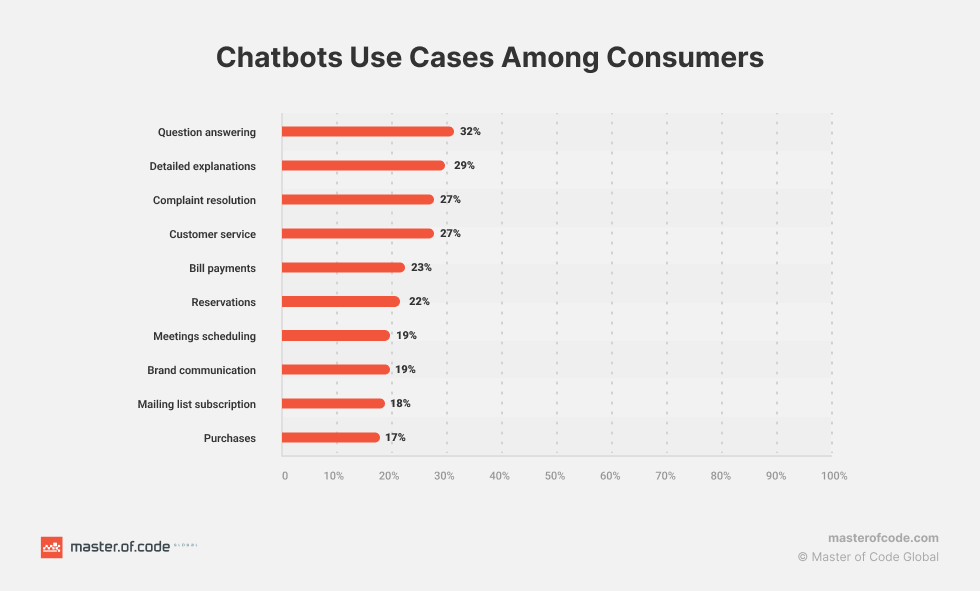
Business Integration and Implementation
- 56% of businesses cite chatbot technology as a transformative force.
- 58% of B2B companies integrate bots into their websites, compared to 42% in B2C settings.
- Small companies (fewer than 250 employees) constitute around 40% of all chatbot-using businesses.
- Among companies utilizing AI bots, 46% employ them for voice-to-text dictation. 26% use them for team collaboration and 24% for employee calendar management. Additionally, 14% use digital assistants for service support, and 13% for IT help desk management.
- 50% of organizations refrain from implementing chatbots due to a lack of applicable use cases. 29% express concerns about security and privacy, and 25% are deterred by cost.
- Approximately 2/3 of companies express contentment with their bot implementations.
- Within companies, 53% utilize AI digital assistants in their IT departments. 23% employ them for administrative tasks.
- Chatbots are most frequently employed in sales (41%) and customer support (37%). marketing (17%) is the third most common application.
Most Popular Chatbot Use Cases
- 35% of individuals turn to chatbots to resolve complaints or get detailed information.
- Chatbot usage doubles for tasks like making purchases, scheduling meetings, and signing up for mailing lists (Drift).
- 41.3% of buyers turned to digital assistants in 2020 for purchases (Drift).
- When seeking information, 54% of respondents would inquire about products via digital assistants. 30% would utilize them for bill payments. Only 23% are willing to delegate dispute resolution to bots.
- 74% of internet users prefer using chatbots for simple questions.
- Digital assistants resolve 58% of returns and cancellations, but only 18% of change in product/service and 17% of billing disputes.
Consumer Preferences and Perceptions
- 87.2% of consumers rate their interactions with bots as either neutral or positive (Drift).
- 62% of respondents prefer engaging with client service digital assistants rather than waiting for human agents.
- 65% of users feel comfortable resolving issues without human intervention.
- 69% of users appreciate digital assistants quick reply times. In fact, 59% anticipate a chatbot reply within 5 seconds.
- 48% prioritize bots’ issue-solving abilities over their personalities.
- Globally, 38% of consumers hold a positive view of digital assistants.
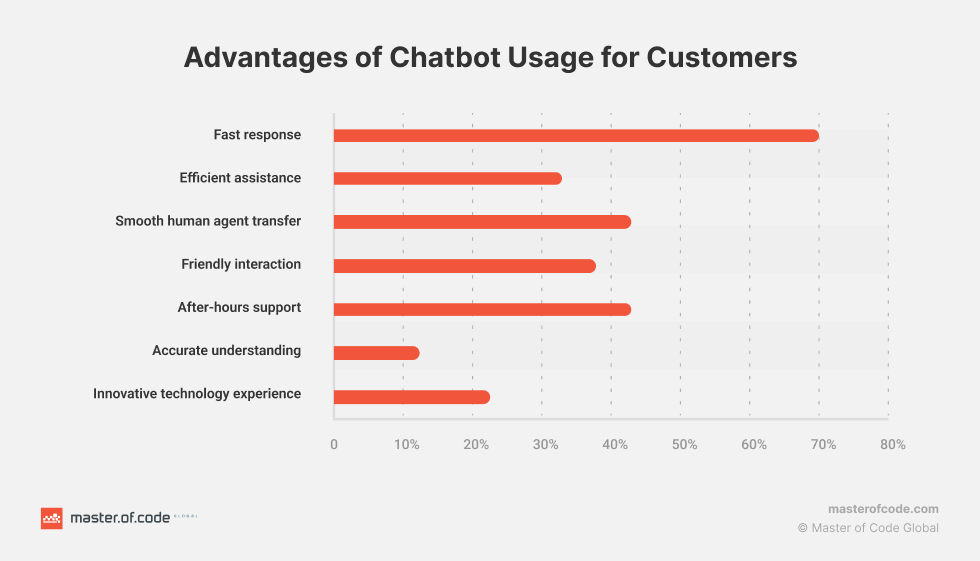
Chatbot Benefits for Business
- According to available data, chatbots have the potential to automate 30% of tasks performed by today’s contact center staff. This could lead to potential savings of $23 billion in the U.S.
- Chatbots can reduce customer support costs by up to 30%, with potential savings of $23 billion in the U.S. alone by automating a significant share of contact center tasks.
- 54% of users find chatbot customer service somewhat effective, while 33% consider it highly effective. This chatbot performance statistics reveal further room to grow.
- The use of chatbots and AI suggestions led to a 22% drop in response times and a 0.45-point boost in customer sentiment. Other positive changes included 70% faster replies and +1.63 sentiment points.
- Response rates for digital assistants vary between 35-40% for less favorable and 80-90% for the most engaging experiences.
- Approximately 64% of internet users consider 24-hour service a key feature of bots. In fact, 29% of bot interactions occurred outside regular store hours.
- 90% of businesses witnessed faster complaint resolution due to the implementation of digital assistants.
- Chatbots can manage 30% of live chat communications. They can also efficiently handle 80% of routine tasks and client inquiries.
- According to a survey, 61% of respondents believed bots could boost productivity by automating task follow-ups. 57% considered they could facilitate more effective communication within the organization.

Chatbot Stats by Business Function
AI chatbots and assistants are employed across various departments. 53% are utilized in IT, 23% in administration, and 20% in customer care. Additionally, 16% of organizations leverage these technologies in sales and marketing.
Customer Service
- 27% of users were uncertain whether their last client support interaction was with a human or a chatbot. Meanwhile, 62% believed AI could speed up responses while catering to their specific preferences.
- 34% of retail clients expressed comfort in conversing with AI chatbots for service support. Additionally, 64% of businesses anticipated digital assistants enhancing personalized support experiences.
- 67% of individuals utilized bots for client support in the preceding year.
- AI chatbots for business enable organizations to shift 64% of agents’ focus to solving complex issues, compared to 50% without AI.
- Virtual assistants reduce inquiries by 70% across calls, chats, and emails.
- 23% of client service organizations rely on AI digital assistants as their main communication channel.
- Chatbots have remarkably accelerated response times, delivering answers three times faster on average.
- Digital assistants led to a 24% increase in support satisfaction scores.
- According to Statista, 1/3 of consumers found bots very effective in resolving queries. 54% deemed them somewhat effective while only 13% considered them not at all effective.
- 80% of sales and marketing leaders implemented or planned bots integration into customer experience (CX).
- 23% of client service companies actively utilized AI chatbots.
- 70% of consumers in 2020 expressed interest in using digital assistants for basic customer service needs.
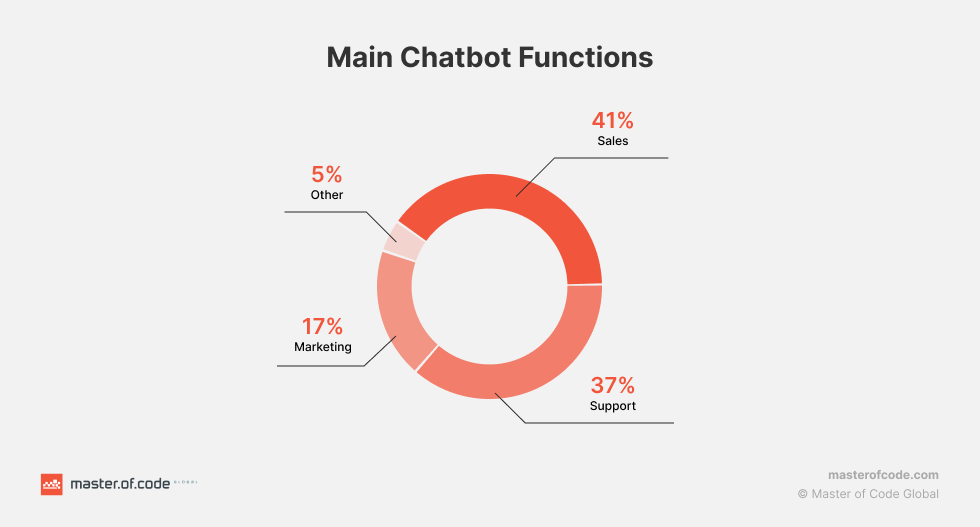
Marketing
- According to the recent chatbot marketing statistics, 55% of companies using chatbots for marketing experience an increase in high-quality leads.
- In specific industries, chatbots achieve conversion rates as high as 70%.
- Stores see annual revenue surge by 7 to 25% when effectively utilizing bots.
- Digital assistants contribute to upselling in 20% of cases, boosting sales opportunities.
- 53% of buyers are more likely to shop with businesses offering messaging services.
- Chatbots excel in traffic segmentation and targeted product ads, driving 77% of a company’s ROI.
- 36% of companies enhance lead generation using digital assistants, with 62.5% using them for lead qualification.
Sales
- Business leaders have reported a 67% increase in sales through the assistance of chatbots. Furthermore, 26% of all sales transactions initiate from a bot interaction. 35% of business leaders credit digital assistants for closing deals.
- Sales purposes drive 41% of all business chatbot applications.
- 35% of business leaders noted that virtual agents have simplified sales processes.
- 25% of companies utilize bots to recommend products, enhancing personalized user interactions.
- Post-sales and customer service operations benefit from digital assistants. 77% actively engaged in assisting clients after their purchase.
- Upselling opportunities are leveraged in approximately 20% of cases.
- CX profoundly influences buying decisions, with 73% of customers emphasizing its importance. Moreover, 86% of clients are willing to pay a premium of 13%-18% for an enhanced CX.
- 56% of companies recognize conversational bots as industry disruptors. And 43% report competitors’ adoption. Additionally, 57% of businesses recognize chatbots’ substantial ROI and minimal effort requirements.
- 23.7% of inquiries convert into sales without human intervention.
- Sales digital assistants turn over 28% of website visitors into leads.
HR
- 62% of people use virtual assistants to satisfy their HR needs.
- 92% of HR departments guide new employees to chatbots for accessing information.
- 66% of HR leaders think their workers feel comfortable using bots to get info about policies.
- 92% of teams recognize the value of an HR AI assistant in guiding employees to the information they need.
- The user journey with AI tools is so seamless that 73% of candidates couldn’t recognize whether they were interacting with a bot.
- Career websites that employ chatbots to engage with job seekers encounter a significant boost, including 95% more leads, 13% more clicks on job requisitions, and 40% more completed job applications.
Chatbot Stats Landscape: Key Industry Statistics
In different sectors, satisfaction with chatbots varies. B2C companies, dealing with simpler queries, tend to be twice as satisfied as B2B companies. The most content industries include tech (73% ), retail (67%), manufacturing (57%), and healthcare (56%).

Certain industries profit notably from chatbots. Real estate (28%), travel (16%), education (14%), healthcare (10%), and finance (5%) lead in this regard. When it comes to informational bots, health (64%), communications (59%), and banking (50%) industries embrace them the most.
eCommerce & Retail
- An estimated 70% of bots were projected to be retail-based by 2023. This trend was expected to drive eCommerce transactions via digital assistants, reaching $112 billion by 2023.
- As per the recent eCommerce chatbot statistics, 33% of consumers express a desire to use chatbots to make reservations at hotels or restaurants.
- The willingness to use digital assistants for purchases surged from 17.1% to 41.3% between 2019 and 2020.
- eCommerce stores adopting Facebook Messenger, coupled with abandoned cart chatbots, have boosted revenue by 7-25%.
- The acceptance rate of bots among clients in retail is 34%.
- Predictions for 2024 suggest global consumer retail spending via digital assistants will reach $142 billion.
- Nearly 40% of internet users worldwide prefer chatbot interactions over interactions with virtual agents.
- A significant 47% of consumers are open to making purchases using bots. 71% of Gen Z individuals actively seek products through bot interactions.
- 40% of U.S. consumers have utilized retail digital assistants.
- Among online retailers surveyed, 76% have either implemented or are planning to integrate chatbots into their CX strategies.
Finance & Banking
- 54% of customers favor using a finance chatbot for payment transactions.
- In the finance sector, bots are accepted at a rate of 20%.
- In 2022, over 98 million users (about 37% of the U.S. population) interacted with a bank’s bot. This number is expected to grow to 110.9 million users by 2026.
- All of the top 10 largest commercial banks have integrated digital assistants into their client service strategies.
- Banking chatbots can improve first-call resolution rates by 20%, increasing it from 50% to 70%, enhancing user satisfaction.
- By 2023, digital assistants were estimated to save banks between $0.50 and $0.70 per interaction, totaling around $7.30 billion in global savings.
- Financial service companies can save more than 4 minutes per inquiry by utilizing chatbots.
- Banks have the potential to automate up to 90% of their customer interactions using digital assistants.
- 80% of financial institutions view bots as a valuable opportunity to enhance their client service.
- Over 43% of customers in the USA prefer using chatbots to resolve their banking issues.
- Banks incorporating digital assistants into their client service can boost their revenue by up to 25%.
Insurance
- The insurance chatbot market’s value is expected to reach $4.5 billion by 2032, displaying rapid growth at a CAGR of 25.6% from 2023 to 2032.
- 77% of senior executives report being at some stage of AI adoption, including the use of chatbots.
- Within the insurance industry, 83% of customers express satisfaction with chatbot interactions. However, the acceptance rate for digital assistants in insurance remains at 13%.
- In 2018, only 5% of insurance companies utilized AI in the claims submission review process. 70% showed no consideration for its implementation at that time.
- 44% of clients find bots suitable for claims processing. 43% prefer them for insurance applications.
- AI bots can handle over 95% of users’ conversations, reshaping communication in insurance.
- Insurance chatbots can manage 80% of inbound inquiries. Additionally, they redirect the remaining 20% to human agents.
Automotive
- The auto AI chatbot market was valued at around $60.48 billion in 2024 and is projected to reach $247.1 billion by 2032, growing at a 19.2% CAGR from 2026 to 2032.
- More than 90% of car dealerships in North America now feature chat support on their digital platforms.
- Top inquiries handled by automotive AI chatbots include: 31% about new vehicles, 20% related to used cars, and 28% for booking service appointments.
- Virtual assistants successfully resolve about 90% of incoming questions without human input. For the remaining 10% of more complex cases, bots collect customer details and route the inquiry to a dealership representative for follow-up.
Real Estate
28% of real estate businesses have already implemented live chat technology to support customer interactions.
According to a global Deloitte survey, over 72% of leaders are either planning or actively investing in real estate AI chat-based solutions.
In an empirical study, users rated the virtual assistant’s performance as follows:
- Response accuracy: 3.5 out of 5.
- Speed of reply: 4.5 out of 5.
- Overall user experience: 4.25 out of 5.
Media & Entertainment
- The global AI market in this field is projected to reach approximately $120 billion by 2032, growing at a 26% CAGR from 2023 to 2032.
- 92% of creators have already experimented with Generative AI chatbots; a sharp rise from just 34% in late 2023.
- Over half (52%) of people say media AI tools make them more resourceful and time-efficient.
- GenAI assistants help writers with lower divergent thinking scores boost story quality and enjoyment by 20–25%, matching the output of more naturally creative peers.
- In team settings, GenAI bots increased idea generation by 8%, though it also led to a higher volume.
- By 2035, 77% of consumers say they’d like to use AI to screen ads and promotional content on their behalf.
Telecom
- In the telecommunications industry, the acceptance rate for chatbots stands at 25%.
- The IT and telecommunications sectors are at the forefront of machine learning (ML) utilization. 52% of companies extensively employ digital assistants for various purposes.
- Call center chatbots enable 82% of users to access services without enduring long queues.
- AI in the telecommunication market is projected to reach $10 billion by 2028, expanding at a robust CAGR of 37.4%.
- Currently, 63.5% of telecom companies are integrating AI to enhance their network infrastructure.
- 56% of telecom customers opt for self-service to select the best plan. Additionally, 77% of consumers choose self-service channels for bill payments and account recharges. (Haptik)
- Personalization drives significant revenue growth, ranging between 5% and 15% for telecom companies. And digital assistants facilitate personalized interactions.
Healthcare
- The healthcare chatbot market is set to reach $431.47 million by 2028, growing at a rate of 15.20%.
- AI and bot technology can automate over 70% of administrative tasks in the healthcare industry.
- Currently, 68% of healthcare organizations are incorporating AI.
- Bot interactions in the healthcare sector currently have a success rate of just 12%. However, it’s expected to improve significantly, potentially handling up to 75% of human healthcare queries.
- A national survey in 2021 revealed that 22% of adults had utilized a mental health chatbot, and 47% expressed interest in using it if needed. During the COVID-19 pandemic, nearly 60% of users started utilizing mental health chatbots. 44% exclusively relied on digital assistants without seeking human therapy.
- Consumers acknowledged the benefits of mental healthcare bots (65%) and their importance (74%). However, 86% felt digital assistants lacked understanding or display of human emotions.
- Physicians believe chatbots would be helpful for scheduling doctor appointments (78%), locating health clinics (76%), and providing medication information (71%).
Travel
- 25% of travel and hospitality companies use digital assistants for general inquiries and bookings.
- In restaurants, hotels, and guesthouses, 33% of consumers are embracing web tools powered by chatbots.
- Among the top 5 industries benefiting from bot adoption, the travel sector comprises 16%.
- A significant 33% of users express the desire to use digital assistants for making reservations at hotels or restaurants.
- Two-thirds of respondents find chatbots useful (40%) or very useful (26%) for managing their business and travel arrangements.
- For travel plans and booking comparisons, 37% of users prefer intelligent bots.
- A high demand for digital assistants that save time and money is evident. 87% of users expressed willingness to interact with a travel chatbot offering these benefits.
- 79% of users expressed willingness to ask for help from a bot if it can function as a concierge.
- In late 2017, SITA reported low adoption rates, with only 14% of airlines and 9% of airports utilizing chatbot technology. However, 68% of airlines plan to adopt airline chatbot services in the near future as well as 42% of airports.
Voice Assistants Statistics
- Industry reports show a sharp rise in voice-enabled interfaces, reaching 8.4 billion by 2024.
- 72% of US consumers have interacted with voice interfaces in business settings.
- The voice assistant market is set to grow from USD 4.59 Billion in 2022 to USD 30.72 billion by 2030, with a 31.2% CAGR.
- Over 90% of people aged 18-64 seek information about voice technology, and more than 70% use it at least once.
- 93% of consumers are satisfied with their voice assistants; 50% are very satisfied.
- 80% of buyers shopping via voice assistant are satisfied, and 50% have made purchases.
- 74% of clients use mobile voice assistants at home, with 71% preferring voice queries over typing.
- 51% of voice shoppers research products, 22% make direct purchases, and 17% reorder items. Additionally, 30% track packages, and 20% leave reviews.
- 71% of consumers are satisfied with voice assistants on their mobile devices.
- Food (56%), banking (44%), and retail (35%) are the most popular industries for voice assistant use.
Future of Chatbots Stats
- Larger companies have embraced chatbots at a faster pace, holding over a 46% share in the market. And this trend is expected to continue, with their share growing by 2027.
- Capgemini predicts 70% of consumers will replace physical visits to shops or banks with voice assistants in the next three years.
- Retail consumers are anticipated to spend over $142 billion via bots by 2024. It’s a significant increase from $2.8 billion in 2019, as reported by Insider Intelligence.
- Gartner predicts that by 2027, digital assistants will become the primary channel for client service in 25% of all businesses.
- 1/3 of AI startup founders believe that digital assistants will be the most popular customer technology in the next five years.
- It is projected that AI bots will power 95% of all customer service interactions by 2026.
- With advancements in ML, AI, and natural language processing, chatbots are expected to become more human-like. This is facilitated by the ChatGPT adoption and the development of new AI programs.
Quick FAQ
How many people use chatbots?
Over 1.4 billion individuals actively utilize messaging apps with chatbot access, and that number is growing fast. In 2022 alone, 88% of people reported chatting with a bot at least once.
How many users rely on AI chatbots?
Recent studies show 54% of consumers are open to using this technology, and with generative AI booming, that number keeps climbing.
How many companies use chatbots?
Roughly 78% of firms have integrated virtual assistants or Conversational AI into at least one business function, especially in customer support, sales, and marketing.
Which industries employ chatbots the most?
Top adopters include tech, retail, healthcare, manufacturing, and finance. But bots are also making waves in real estate, travel, education, and automotive.
Don’t miss out on the opportunity to see how AI chatbots can revolutionize your customer support and boost your company’s efficiency.

